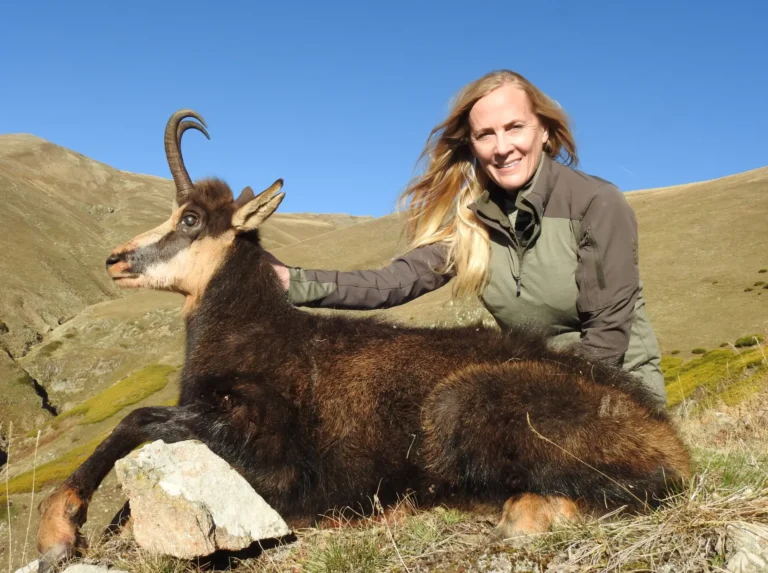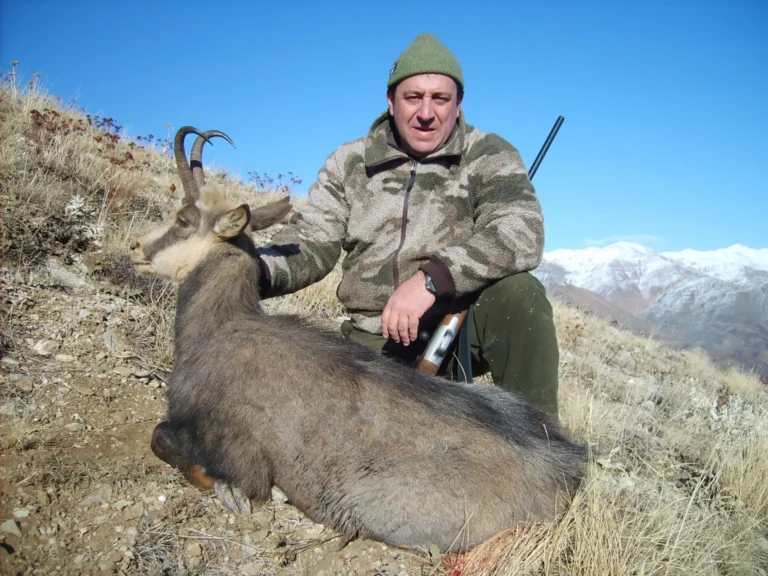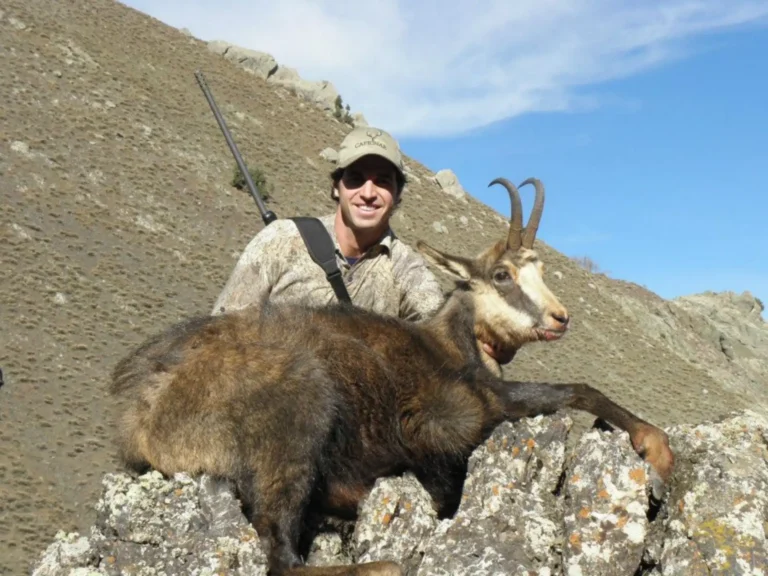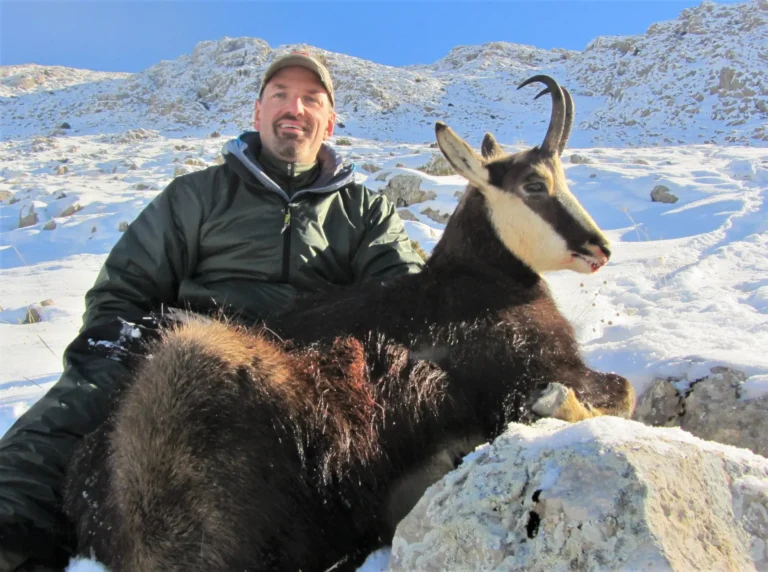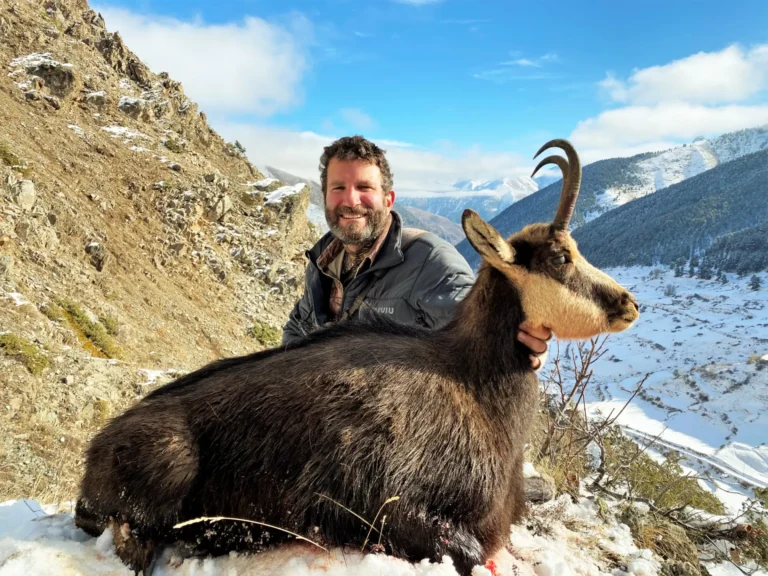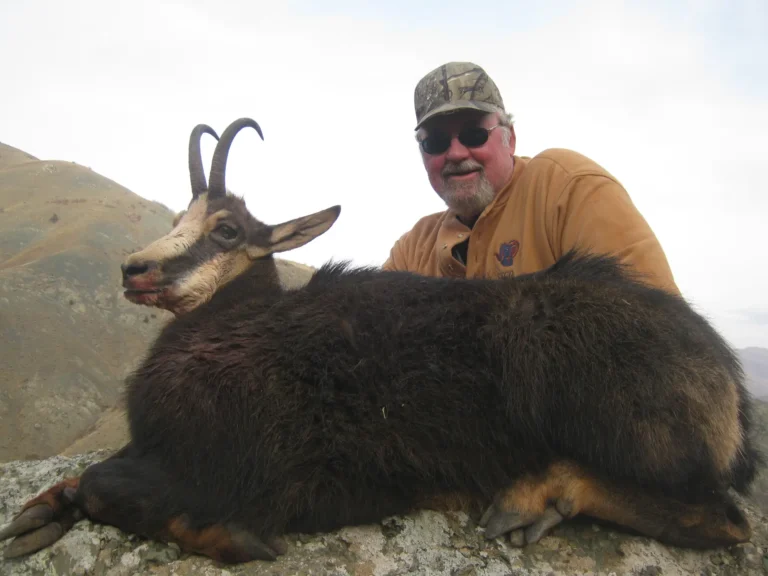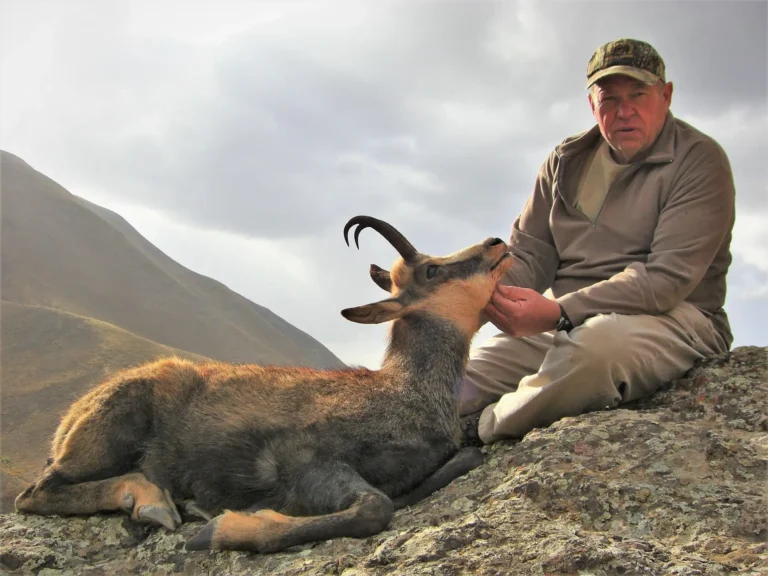Much controversy and confussion exist concerning the taxonomy of chamois. But most authorities agree on that there are about eleven distinct subspecies of chamois around the world and ten of them are huntable. Chamois has a very wide distrubition range around the world but the main concentration is in central and southern Europe although its eastern range goes as far as the Northeastern corner of Turkey and Caucassian range in Southwestern Russia. Contrary to popular belief, chamois is not a goat, but belongs to the antelope genus of which it is the only specimen inhabiting Europe. But due to it is goatlike life style many consider it a part of Capra family.
Anatolian chamois (Rupicapra rupicapra asiatica) is solely indigenous to Turkey but a small strip of population extends into southwestern part of Georgia. There are two main subpopulations in Turkey. These inhabit the most secluded parts in the northeastern mountains of Blacksea region between the cities of Rize and Artvin and as well as the alpine parts of the mountains between the clities of Erzincan and Tunceli in the eastern part of the country. These two pre-connected subpopulations became isolated in time due to human disturbances. Both distrubition size and population of rupicapra asiatica has decreased dramatically in the past two decades. There is not a certain figure related to the overall population size of Anatolian chamois, therefore the number of permits issued by the General Directorate of National Parks and Game-Wildlife (TGDNPGW)annually has only been very limited in the past decade which makes the animal much sought after by the species collectors.
There is perhaps very few wild game animals so peaceful and at the same time so timid as the chamois. Nature therefore has enabled chamois to guard against the approach of danger by the great acuteness of its senses of sight, smell, and hearing and endowed it
with an ability of climbing into the most inaccessible places, and thus avoiding pursuit. It is this skittishness which makes it so difficult to hunt them in their own habitat. If chamois has only one weakness, it is his curiosity. Many bucks during the rut may mistake incoming hunters for a doe or a rival buck, and makes a dash for it. And many pay dearly for their mistakes. Likewise a fleeing chamois will often stop for a quick look back which can give the hunter a good opportunity for a shot.
A rolling stone or a spoken word at once attracts their attention; and they will look and listen to discover where the sound comes from which breaks the silence of their mountain solitude. For an incredibly long time they will stand, gazing fixedly in one direction. The eyes of the whole herd then will be fixed on the spot in a long steady stare. Hunter caught in such a position spends a long time motionless.
The sharp whistle “phew” tells they have fathomed the mystery, and away they move to the precipitous rocks ovehead. Unless panic-stricken, they stop from time to time to look behind; and then suddenly uttering the peculiar shrill sound, again move on. When feeding, they often post a lookout that will warn the rest of the herd of approaching danger by stamping hooves on the ground and using the same whistling sound.
The eye of chamois is large, dark, and intelligent. It is full of animation, but this, in its expression of keen watchfulness, is the animation of fear. It carries its head errect, and its graceful ears pointed, as if prepared against surprise.
The horns, which are black, rise from the head just above and between the eyes. They are round and rougher at the base, but incline somewhat to flatness towards the top, which is smooth and polished. They do not stand up perpendicularly, but slant forwards at a right angle with forehed. Their points which are very sharp, being bent back and downwards. This feature is not peculiar to the buck alone. There is considerable difference between the horns of the male and female, which often assists the hunter in distinguishing the two. The horns of the male chamois are thicker and althogether stronger-looking than those of the female. And instead of diverging from each other in a straight line as female horns generally do, their outline describes a slight curve as they rise upwards and apart from each other. But a still, more striking charagteristic of the buck is, that the points of his horns are bent much more inwards than those of the female chamois. Hers form a semicircular curvature towards the back, while his, turning over abruptly, form rather a hook. This gives the head quite another expression.
Although when near, all these peculiar differences in the horns of the buck and doe are easily observable, at a distance the distinction of course is not so evident. And the male is then recognized by his stronger built, by his general appearance and more gallant bearing. But it requires a very practised eye to distinguish it with chamois. However some old females offer excellent trophies.
Horn lenght of 9 inches (23cm) considered by most to be trophy size for Anatolian chamois. As a general rule, if a buck’s horns appear to be 2-3 inches higher than the top of its ears, then it is likely that you are looking at a 9-10 inch male chamois.
The hair of chamois changes in color at various seasons of the year, as is the case with many game animals. During the summer months, chamois wear a lighter colored coat of varying chestnut-hazelnut tones, ranging from a very light beige to reddish, with a dark dorsal stripe that runs along the entire back. The winter coat is of a more intense shade of colours, varying from dark brown to almost black. But though the changes here indicated may be looked upon as a general rule, there will often be found in the same herd one or more differing strikingly from the rest.
SEASON & WEATHER
The hunting season for Anatolian chamois in Turkey kicks off by early August and runs until the end of January, the following year. Typically, chamois keeps very high, on top of the mountain in some areas as well as in the woods in other localities during early season. Old billies remain alone in their inaccessiable and secluded places which makes locating them a bit challanging and getting to him harder. It is only when the winter has set in and the rutting season begun, that there is any chance of seeing them.
While Anatolian chamois can be hunted any time during the hunting season, November seems to be the best time when the chamois indulge itself in mating. The rut for rupicapra asiatica takes place in November. During this period, some of the male chamois start wandering around in search of females, and thereby, occasionally penerate the territories of other males that shows territoriality. That is when stronger bucks make their appearance, and fierce battles take place. December and January are the hardest time since the hunters may have to deal with deep snow and cold weather conditions. On the other hand, deep snow may present some adventages as it will push the chamois herds towards lower elevations.
At this period a sort of bladder forms beneath the skin of at the root of the buck’s horns, which generate a strong, musk-like smell. If the chamois is shot at this time the odour will remain for years. Generally a male chamois weigh around one third more than females close to the mating season. However this fact changes once the rut starts and the difference shrinks back during the rut as the bucks lose a considerable ammount of body weight.
The weather with early season hunts is normally nice and warm during daylight hours of the day. The temperatures may be anywhere between 18-25C (64-77F) degrees. But by the begining of November temperatures fall (10-15C / 50-59F ) and the first snow fall can be expected on mountain tops in the second half of the month. We highly recommend hunting in November to catch the rut in order to have a better chance for older/bigger bucks. As happens with many other species, mature chamois males also tend to lead a solitary life, and they approach female herds only during the mating season. This makes them easier to spot. But hunters in good physical shape can successfuly hunt chamois in September and October as well although the chamois tend to be a bit higher. However animals are plentiful and most areas have road access which makes hunting a lot easier.
January may be the hardest or the easiest time for hunting the Anatolia chamois.
AREA & ALTITUDE
Anatolian chamois haunts the northeast part of the country and also some small pockets of mountains in the eastern provinces. There are only a handful localities where Anatolian chamois hunting is permited throughout Turkey. However until recently, hunting for this species was allowed only on the Kackar Mountains which form the northern section of the Anatolian mountain range. With the opening of new areas in the eastern parts, new spots for the trophy hunters became available. In these areas Anatolian chamois live in healthy numbers yet, due to shortage of these areas that are open to trophy hunting, the number of tags issued are very limited and in short supply.
Caprinae Safaris guests for Anatolian chamois are accommodated in the best hotels that is available in the area. Hunting areas are reached by a 4×4 ride of 30-60 minutes every day. In some areas mountain roads allow the hunters to drive a nearby location before the last stalk takes a place.
Chamois typically haunt the steep hill sides near the tops of the mountain, delighting in the highest and most inaccessible places. And it is only winter sets in with all its rigour, that they descent to seek shelter and food in the woods somewhat lower than the mountain. Two major considerations while glassing to locate chamois are the steepness of the terrain and the vegetative cover. They may be out feeding on a relatively flat ground but they prefer to remian close to some steep hillsides dissected with small gulleys and ridges so that they can make a bolt through a nearby ravine or a bluff.
The agility of the chamois has become almost proverbial. But to have any idea of what it is, one must be an eye-witness of the bounds they make, and see the places they will race down at full spees when pursued. A smooth surface of rock, so smooth that a footing there seems impossible, and of nearly perpendicular steepness, is no obstacle to their flight.
ACCOMMODATIONS & HUNTING METHOD
Accommodations for the Anatolian chamois hunt in Turkey differ from area to area. While the lodging is done in nice local hotels in some of the areas, guest houses in villages can also be used to accommodate hunters in others.
Any chamois, Alpine or Balkan type, regardless of the subspecies, have a tendency to always be looking downhill for approaching danger. A thumb of the rule should to get above them and stalk from there if the terrain allow. Ideally the hunter should be in chamois country by the first light of the day since the animals are most active in the morning and late afternoon hours. Typically chamois will take a break in mid day to chew his cud and will be less visible to searching binoculars while they have an addvantage to detect intruders. They can be located much easier when they are up and on the move and more vulnarable while feeding.
Another advantage to being higher than chamois is the fact that uphill wind currents in a sunny day will often override the prevailing wind direction. The daytime air movement from below towards up will keep the human scent away from the chamois. Hunters start the day early and sometimes climb above the tree line before the sun gets too high. But, most of the areas are reachable by trucks and more often 4×4 trucks can carry the hunter either to the top of the mountain or to a closer point.
Curiosity is the defective side of chamois. They are inquisitive animals and they often come in full speed and investigate something that seems out of place, especially when they are in rut. A trick that is often used by hunters to get chamois’s attention is to hide behind a rock and wave a hat or a piece of cloth etc. Most often a young buck will fall for the trick

